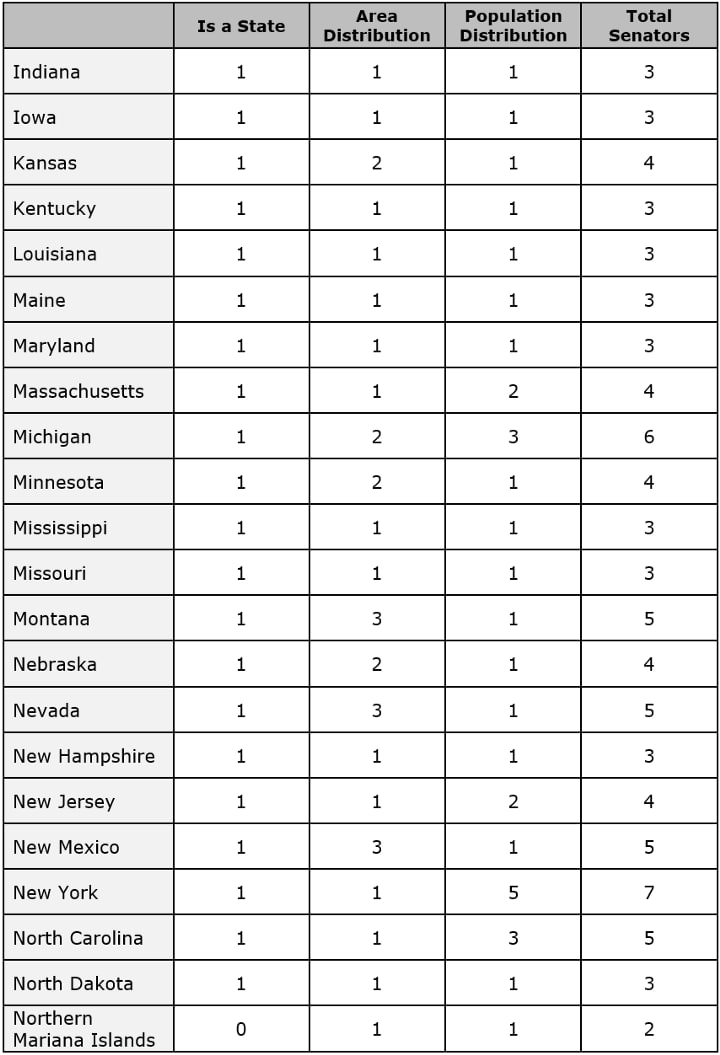
» KEY POINTS
- In order to balance power in the Senate, each State and Territory should receive a set of Senators in relation to their population and another set in relation to the amount of land they control.
- The Senate should increase in membership while the House of Representatives should shrink.
- All members of Congress should be elected on 4-year cycles that expire in the middle of Presidential terms, resulting in country-wide federal elections every 2 years.

As set up today, the Senate makes absolutely no sense. Every State has two Senators despite any and all factors. That means that small States with more sheep than people have as much say as a State with the largest amount of people and almost the largest amount of land. Meanwhile, the most massive Territories that are physically and population wise bigger than half the rest of the country have no say whatsoever. It is an incredibly imbalanced solution to a real concern.
The genuine issue that the Senate tries to resolve is that the Federal Government needs a check on it from the States so that the former does not become too powerful and trample on their rights. While this was the gravest concern in the late 18th century, this is still a logical — though not as pronounced — consideration even today. In order to balance out the will of the Federal Government, there must be a counter. However, the counter needs to be fair to all constituents within it.
More so, demographics are making it so that the Senate is becoming even more unfair and lopsided. A University of Virginia study estimates that by 2040 around half of the population will be living in only eight states. Since each State has two Senators no matter what, that means that half of the country would be represented by just 16 votes while the other half from sparse States will have 84 votes! Now, we could go further into political affiliations with sparsely populated areas, but that is too simplistic of a story on voting patterns. The real takeaway is the population disparity alone.
In case this is not obvious, the first thing that must change is the makeup the number of Senators and how they are distributed:
By Amendment to the Constitution of the United States, Article 1, Section 3, Clause 1 shall read:
The Senate of the United States shall be composed of at least two Senators from each State and Territory with a permanent population, elected by the people thereof, for six four Years on the even years opposite elections for President and Vice President; and each Senator shall have one Vote. The total number of Senators received by each State and Territory shall be one Seat for each State and zero Seats for each Territory; plus a proportional distribution of one hundred Seats based upon the total population of the States and Territories; plus a proportional distribution of one hundred Seats based upon the total land area of the States and Territories; such that each State shall have no less than three Senators and each Territory shall have no less than two Senators. The legal body of each State and Territory shall determine the method by which Senators are elected.
Further, Article/Amendment 17, Clause 1 shall exclude the following components:
The Senate of the United States shall be composed of two Senators from each State, elected by the people thereof, for six years; and each Senator shall have one vote. The electors in each State shall have the qualifications requisite for electors of the most numerous branch of the State legislatures.
Should the House of Representatives become a mechanism to reflect the overall will of the people, the Senate should be a reflection of the States to keep in check the Federal Government, but still be a fair and balanced one to what they represent. As such, the Senate can be thought of as the “Legislature of the Land”, where the borders — as artificial as they are — determine an area that needs a say. Yet despite that need, the Senate requires a check within itself so that undersized and underpopulated States cannot have outsized influence over larger ones, and at the same time making sure the larger ones cannot act with impudence over the smaller ones. And on top of that, everyone must think of making sure all Americans are represented in the Senate.
Given those criteria, the first change is the relative number of Senators by saying that each State and Territory must have at a minimum two. Of note, populated Territories are included so that the millions of people living in those places and the thousands of square miles they cover are not excluded. However, with the Senate, there is an important distinction in Territories that have a permanent population. It must be highlighted that there are several more Territories that do not have populations and therefore are truly under the direct control of the Federal government. These areas do not need special attention because there is no one to represent!
Continuing on this path, there is then a distribution of available Seats. While we need to condense the House of Representatives, we must expanded the Senate within certain confines. Where the House of Representatives needs pruning for efficiency, the Senate needs expansion to limit power mongering.
The first part was saying that if the location were a State it would receive a Seat and that if it was a Territory with "permanent population", it would not. While much can be said about the importance of including Territories and the populations within, there are certain rights and responsibilities that come with being a full-fledged State. This is one of those areas where it makes sense to put a distinction to incentivize Territories to become full States and to make sure Territories do not have an outstripped role. This is yet another check on the system, constraining States and Territories with each other.
That is not to say Territories would not receive full representation, though. As the next part lays out, there would be 100 Seats to be distributed by physical area and another 100 Seats to be distributed by population. Given the current layout of the United States, this would result in a total of 250 seats — which would go up slightly by 1 as Territories became States or a new State were admitted to the Union. One of the main concerns right now is what if Texas or California split into many States and each State received two Senators. This would give these new States a massive amount of voting power, especially if they voted as a block or close to it. Instead, having more Senators to curb the impact of additional ones while also limiting what one gets just for being a State makes this a more smoothed-out growth and distribution curve.
The distribution curve is the most important part, as well. If California or Texas were to split up, the percentage of the land and population each new State were carrying would limit the power of each one. The total number of Senators would be slightly higher, but the distribution would reflect what is within the borders of each. On the other side, if a new State joined the Union, then there would be a redistribution and some States may lose a Seat so the new ones could gain.
What you will notice is that this reimagining of the Senate is rather silent on the method by which the distribution is to happen, and this is intentional. If you take a straight percentage — and say those below one percent must at least get one of each Area and Population and round the rest — this will not work and you will end up with far too many Senators. If you keep the 1% rule but round down, you may end up with too few. Instead, certain other criteria needs to be put in place in order to determine how the States receive their Senators.
In this example, I have used a method where each State must get at least one Senator in each Area and Population, even if their percentage is below 1%. Then, the threshold for rounding Area was set whereby 0.87+ will round up and everything below will round down. This yielded the perfect 100 Senators for Area. A similar method was tried for Population, but due to some tight numbers even a 0.999999999 rounding requirement still yielded 101 Senators. In the end, Indiana being the state with the least population and more than 3 Senators had to have one removed. Apologies to Indiana. The result was this:



Of the 56 States and Territories, exactly half (28) ended up with 2 or 3 Senators. Among the States and Territories at the top of the charts, Alaska is by far the biggest winner expanding to 19 Senators based almost solely on its massive land area (which might make a case for splitting Alaska up, but that is not a concern for this particular argument). Outside of Alaska, though, the real winners were as expected with California and Texas each receiving 16 Senators — the exact outcome one would surmise for States with such vast amounts of area and populations to go along with them. The next highest States were Florida at 8 Seats and New York at 7 Seats. Though a precipitous drop off, it does reflect fairly the two factors of population and size. From there it continues to drop off so that States with large populations and small sizes (like Massachusetts) share the same number of Senators with those that have small populations and large sizes (like South Dakota). None of the Territories escaped their 2-Seat minimum.
Note that this is just an example and Congress may make other decisions on distribution, but it shows the methodology in play. It makes sure States and Territories that have more land and people in turn have a large say while also making sure that no area has too little say or blocks of votes. There may be slight modifications to the method based on how large populations and land are in the future, and as such this modified Clause now allows the flexibility while giving a more equal distribution of power. Again, it is not completely even, nor is it 100% fair; it is just intended to level the playing field without going overboard to create perfection.
Beyond the setup, the Senate should be elected every four years in totality and on the even years opposite the Executive Branch. If the House of Representatives did the same, this would ensure that the entire Legislature is renewed during the term of the President and serve as a check on power or a will of the people. Most importantly, this would make each 2-year cycle for elections incredibly important because so many positions would be being filled.
Critically different than what could be imaged for the House of Representatives, though, is that the Senators would be selected in a method decided by the States and Territories themselves. Once they know how many Seats they have, the method they choose to fill them is up to them save for being elected by the people. Now, it would be hoped that they would fill them in distributed manner akin to what is recommended for the House of Representatives, but that is a regional decision that must be up to each locale, as is the right of any State/Territory.
These particularities were pulled up and out of the Amendments and into the main document; and were additionally further clarified. For instance, before the 17th Amendment, the Constitution made it sound like the largest Party in each State’s Legislature could come up with some way of deciding who could be a Senator. This has now been laid out to specifically say the “legal body” of each State or Territory in general decides the method for electing Senators, within the confines of elections by the people.
Of course, now that we have a larger number of Seats and method to fill them, the occasional vacancy will happen. As such, the next Clause covers how that is resolved:
By Amendment to the Constitution of the United States, Article 1, Section 3, Clause 2 shall be merged with Article/Amendment 17, Clause 2 and together shall read:
Immediately after they shall be assembled in Consequence of the first Election, they shall be divided as equally as may be into three Classes. The Seats of the Senators of the first Class shall be vacated at the Expiration of the second Year, of the second Class at the Expiration of the fourth Year, and of the third Class at the Expiration of the sixth Year, so that one third may be chosen every second Year;
When vacancies happen in the representation of any State or Territory in the Senate, the executive authority of such State or Territory shall issue writs of election to fill such vacancies: Provided, that the legislature of any State may empower the executive thereof to make temporary appointments until the people fill the vacancies by election as the legislature may direct the method chosen by the State or Territory.
With elections now happening every four years in totality, there is no need at all for the original statements in Clause 2 that cover Senator expirations from the time of the signing of the Constitution to today. Instead, the Clause can pick up what is already in Amendment 17, Section 2 to discuss filling vacancies. The only updates are technical, with a note to include Territories and removing that the specific method for voting for Senators to the method chosen by the State or Territory. This is important in case the State chooses a List-type method like with the House of Representatives. The Constitution should not be telling the States and Territories what their method is; the States and Territories should be informing the Federal government.
The pre-existing clause also allows the Executive Branch of States and Territories to fill vacant Senate seats on a temporary basis if allowed by their Legislatures (or Constitutions). This is maintained as a logical clause because it already has the out of being a decision left entirely to the States/Territories. Because the Senate is about the State’s/Territory’s power to check the Federal Government, then this should remain unchanged.
As with House of Representatives, there are some arbitrary age requirements for being a Senator that should be removed:
By Amendment to the Constitution of the United States, Article 1, Section 3, Clause 3 shall read:
No Person shall be a Senator who shall not have attained to the Age of thirty Years voting maturity as defined by the Constitution and Congress, and been nine Years a Citizen of the United States, and who shall not, when elected, be an Inhabitant of that State for which he shall be chosen be a citizen of the State or Territory chosen during the election and throughout service to the Senate.
The story is the same: if you are old enough to vote, you are old enough to serve. Additionally, the language of Clause 3 is rather obtuse, so this update clarifies that one must be a citizen of where they represent both at the time of election and during the entire course of their service to the Senate. However, the rule for “nine Years a Citizen of the United States” has been left in place. Although this is an anachronism left over from the Revolution and fear of foreign powers taking over the Senate, it is not distinctly a poor rule like the age requirement. All that statement does is another check to make sure those who serve meet the requirement of working for the country, and this is a test thereof.
A similar test does exist in the House of Representatives, but it is fewer years because foreign nationals may make a percentage of the populace and deserve representation that speaks to their needs should such a Party arise. The Senate — being the check on the House of Representatives — should have a stricter rule in place. There is no functional reason to remove this particular wording, so for now it can stay as is. An argument could be made for the number of years in both situations, but that is up for debate and could be modified (and perhaps even eliminated from the House).
Finally, there is one minor change that is a preview of what is to come:
By Amendment to the Constitution of the United States, Article 1, Section 3, Clause 4 shall read:
The Vice President of the United States shall be President of the Senate, but shall have no Vote , unless they be equally divided.
The only change here is that Vice President can no longer cast a tie breaking vote. Why this is will become very clear later, but the crux of it is that no legislation should need a tie-breaker vote in order to proceed. Also, there is some oddity to having an Executive stand in a Legislative body for any reason, but there may be a use for this that will also be covered in a future section. Therefore, for now, we leave the Vice President in place and do not strip her of one of her limited duties!
From here, there is no need to get involved in the rest of Section 3. The next Clause discusses the President of the Senate pro tempore (the person who theoretically runs the Senate when the Vice President is not there, which is almost always, but more on this role shortly), and the selection of officers as the Senate sees fit. The next two clauses then cover impeachment which by itself is written out fine and with reason. The execution over the past couple of centuries leaves much to be desired, but that may change with a different makeup of the Legislature to begin with. As such, we again leave those alone and prepare to move on to how Congress functions.

The above piece is a mildly modified excerpt from New & Improved: The United States of America by J.P. Prag, available at booksellers worldwide.

Learn more about author J.P. Prag at www.jpprag.com.

An earlier version of this article appeared on Medium.
About the Creator
J.P. Prag
J.P. Prag is the author of "Compendium of Humanity's End", "254 Days to Impeachment", "Always Divided, Never United", "New & Improved: The United States of America", and "In Defense Of...", and more! Learn more at www.jpprag.com.






Comments
There are no comments for this story
Be the first to respond and start the conversation.